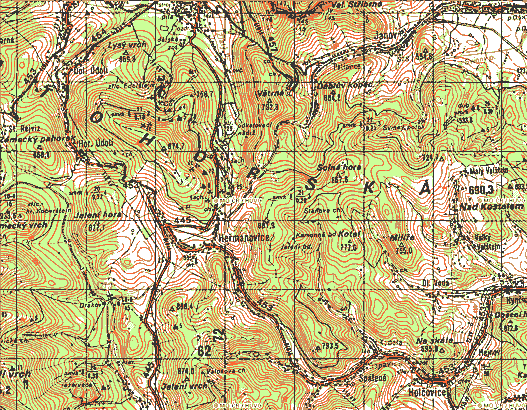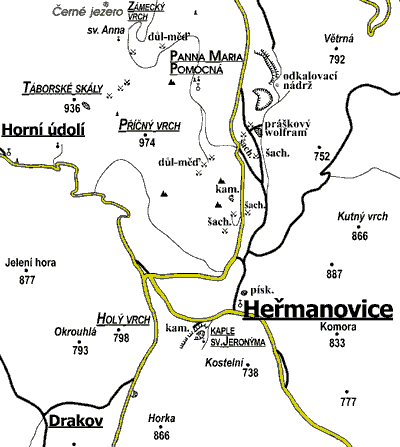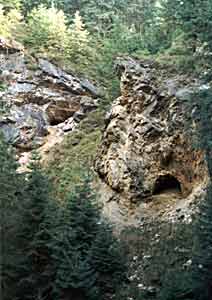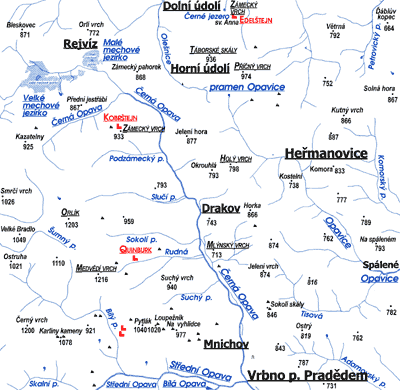Geography


Region of ore and limestone mining


Geological and petrological structure in the area of the village is varied - there are three geological units represented: block mass of Orlík (west of the cadastre - crystalline ore with quartz dikes), Vrbenské strata (in the centre of the cadastre there is a zone of middle and lower devonian rock stretching from Zlaté Hory across Vrbno p. Pradědem to the south with occurrence of quartz reefs and glaucous crystal limestones) and Andělskohorské strata (the east - region of slates and greywacke broken by frequent disruptions).
Limestones and ore beds (gold, silver, copper, lead and zinc) in vrbenské strata are very important. In the past, an interesting limestone cave in Heřmanovice came into existence, with dimensions 18 times 12 m and and the height up to 10 m. The cave had rich dripstone decorations (stalagmites, stalactites, sinter yellow and transparently white curtains) and it boasted of two lakes with sand beds. Unfortunately, in the past years the cave was already destroyed by progressing mining in a local limestone quarry that is located almost at the centre of the village, under Chapel St. Jeroným. There are abandoned iron ore mines (magnetite, hematite, magnet and bloodstone) on the Holý vrch, Mlýnský vrch and on the mining field Maria Trost (to the left of the road to Salaš). There are remnants from the hundred year ore produce in the area of Příčný vrch, for instance: craters, refuse dumps, hollows, cuttings, tips, tunnels, shafts and air-flues. The biggest craters (with diameter up to 60 m and depth up to 30 m), created by back confining layers collapse in large subterranean places can be seen near Táborské skály.
The surface mining of gold was practiced (gold was primarily sluiced) in pays where it appeared from scattered quartz dikes. Old German names for watercourses Goldoppa - Zlatá Opavice - Gold Opavice - is the previous name for Opavice) and routes remind us of gold-washing. Their remnants can be found in Černá Opava and their right-hand tributaries (Slučí potok, Sokolí potok and Rudná).
CLIMATE AND WEATHER
Heřmanovice is located in a cold area with a relatively cold and humid summer (growing season of 135 days) and a long winter (average number of days with snowing is 54, snow cover stays during 102 days per year in average). The average year temperature is from 4 to 6 degrees Celsius, the coldest month is January and the warmest is July.
The average rainfall is from 900 to 1200 mm per year, with most rainfall in July and least in February. To mention an interesting fact, the rainiest day in the recorded village history was on 9th July 1903 with the rainfall of 184,7 mm (followed by a big flood on the river Opavice). Primarily in winter the inversion situation occurs not only in Heřmanovice but in the whole rather a narrow valley of the river Opavice and its influents.
| month | I | II | III | IV | V | VI | VII | VIII | IX | X | XI | XII |
|---|---|---|---|---|---|---|---|---|---|---|---|---|
| avarage tempereture of the air (°C) | - 4,2 | - 2,9 | 0,7 | 5,4 | 10,7 | 13,9 | 15,6 | 14,5 | 11,1 | 6,1 | 1,3 | - 2,3 |
| average rainfalls (mm) | 53 | 50 | 60 | 76 | 101 | 112 | 135 | 107 | 88 | 81 | 62 | 53 |
RIVERS AND CREEKS

Heřmanovice is located in the sea drainage area of the Baltic Sea - all the water is taken away by the river Opava which is an influent of the river Odra. There are two important watercourses in the cadastre - the stream Černá Opava (in the western and central part) and Opavice. The small area at the border with Zlaté Hory belongs to the river basin of the Zlatý potok which joins the river Prudnik.
The stream Černá Opava (the watercourse length in the cadastre is 17,9 km, the drainage basin area is 58,7 sq km, longterm outflow measured in the village Mnichov is 0, 76 m3s-1) rises on the western slope of Orlík, 1400 m above sea level. Under Zámecký vrch it turns to the south and in Vrbno p. Pradědem it joins Střední and Bílá Opava.
Opavice (the stream length in the cadastre is 35,7 km, longterm outflow measured in Heřmanovice is 0,23 m3s-1), whose watercourse running to the south-east forms the axis of the whole village, rises above the northern end of Heřmanovice on the south-western slope of Příčný vrch at 850 above sea level.
All the watercourses have clean water, the western part of the cadastre lies in CHOPAV (natural water accumulation preserves) Jeseníky and the eastern part in the II. (outer) zone of hygienical protection of the source Široká Niva.
Soils
Soils in the cadastre are usually little fertile, gravelly or even stony, wet at some places. Brown strongly acidic soils are most common as well as podzols at highest places. Alluvial plains are covered by gleyed and gleying soils.
| year | 1845 | 1900 | 1948 | 1990 | 2001 | |||||
| ha | % | ha | % | ha | % | ha | % | ha | % | |
| agriculture soil | 1433 | 33,6 | 1463 | 34,2 | 1424 | 33,3 | 1057 | 24,7 | 1063 | 24,8 |
|---|---|---|---|---|---|---|---|---|---|---|
| - orable soil | 1235 | 28,9 | 1337 | 31,3 | 1300 | 30,4 | 465 | 10,9 | 35 | 0,8 |
| - grass land | 189 | 4,5 | 96 | 2,2 | 94 | 2,2 | 568 | 13,2 | 1004 | 23,4 |
| - gardens | 9 | 0,2 | 30 | 0,7 | 30 | 0,7 | 24 | 0,6 | 24 | 0,6 |
| woods | 2735 | 64,0 | 2722 | 63,7 | 2727 | 63,8 | 2978 | 69,6 | 2981 | 69,6 |
| other areas | 104 | 2,4 | 87 | 2,1 | 121 | 2,9 | 246 | 5,7 | 237 | 5,6 |
| total | 4272 | 100 | 4272 | 100 | 4272 | 100 | 4281 | 100 | 4281 | 100 |
Nature
The submontane nature and scenery are protected as a part of Protected Landscape Area Jeseníky (CHKO Jeseníky), which was established in 1969. CHKO Jeseníky lies to the west of the road Vrbno p. Pradědem - Heřmanovice - Horní Udolí and its most precious part in the area of the village is the area around where the river Opavice rises on the slope of Holý vrch. Rare amphibians and protected species of plants can be found in small deciduous forests and on well-preserved meadows (Lilium bubiferum, Dactylorhiza majalis, Epipactis helleborine and Platanthera bifolia).
Present character of the scenery was affected by far-off peasants who gathered great amounts of stones from their fields and laid them along the borders of their grounds. Today, these screes reveal the past ways of the soil cultivation. Often overgrown with bushes and trees, they divide meadows and pastures and they create the unique character of local scenery.
